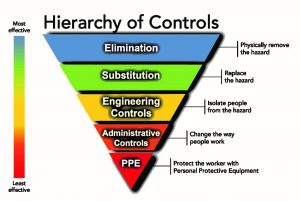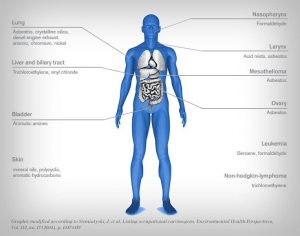SynTerra safety
Hazardous chemical awareness and poison prevention
Posted March 6, 2020

This illustration presents methods of controlling hazards, from most effective to least effective.
Hazardous chemicals and related dangers exist all around us and are part of daily life. Basic knowledge of chemicals and safety precautions is valuable in the workplace and home. Accidental exposure to chemicals can cause a range of injuries. The severity of an injury from accidental chemical exposure can depend on several factors, including age, gender, route of exposure, concentration of the dosage, and duration of exposure. Properly identifying chemicals and making sure they are stored safely can greatly reduce the possibility of injury.
Chemical safety in the home
Did you know? More than 90 percent of all poisonings happen at home. Here are steps toward prevention:
-
- Proper labeling of household chemicals, especially cleaning products, is your first line of defense against exposing yourself to hazardous substances. Example: Using a Sharpie, write “Bleach” on your own self-mixed spray bottles (after diluting with water).
- Properly dispose of old chemicals, cleaners, and prescriptions that you no longer use or are out of date. Many municipalities offer services to properly dispose of chemicals and prescriptions.
- Keep hazardous materials out of the reach of children. On average, more than 300 children are treated for exposure to hazardous materials every day in the United States and two die as a result of poisoning from household substances like cleaners and cosmetics. Keeping such products out of reach of children is essential to protecting your family. Inexpensive latching devices can be purchased and installed to prevent access to those items.
- Over-the-counter products such as eye drops, air fresheners, detergents, and nail polish removers are some of the many items we use on a regular basis that contain ingredients listed as harmful or hazardous in most states. Just because it is designed for home use doesn’t mean it is harmless. For example, the ingestion of large quantities of baking soda (sodium bicarbonate) can lead to
dehydration, seizures, and kidney failure.

This picture shows common workplace carcinogens and organs affected.
- Display the National Poison Control Hotline — 1-800-222-1222 — prominently in your home. If you call this number, you will be routed to the poison center that serves your area.
National Poison Prevention Week, the third week in March, focuses on the danger of drugs and other poisons and how to keep your family safe. For more information on chemicals in the home and how to keep your family safe, visit https://www.nsc.org/home-safety/safety-topics/other-poisons.
Workplace products and chemicals
There are more than 750,000 hazardous chemicals used in the workplace worldwide. The most common routes of entry into the body are inhalation, absorption, and ingestion. Both the employer and employee are responsible for creating a safe environment. Employers must constantly educate employees, and employees must actively participate in learning.
- A product with the label “Danger” is more hazardous than something labeled with “Warning.”
- If you are using a chemical in your day-to-day tasks, make sure you have read and understand the safety data sheet for that chemical. If you do not have safety data sheet, ask your supervisor for a copy. Employers are required to maintain safety data sheets pertaining to the chemicals used in the workplace.
- Asbestos, a familiar workplace carcinogen that is almost entirely banned in manufacturing and distribution, is still used in the production of some items like brake pads, tile flooring, fireproofing caulk, and adhesives. It could very well be in your workplace. Ask your employer about the products used around you to prevent exposure.
- Each year, there are as many as 90,000 new work-related cases of cancer in the U.S. These cases are largely caused by long-term exposure to materials that are labeled as “carcinogens.” However, there are also many substances that are still under consideration and are labeled as “probably cardinogens” or “inconclusive.” Those substances should not be ignored just because they are still being researched.
Find more resources concerning safety with chemicals at www.draeger.com.
All cases of chemical injury and illness are preventable with the right training, education, and resources. At SynTerra, we coach our employees and provide our clients with services to minimize the day-to-day risks associated with accidental chemical exposures. We provide training sessions and on-site Health and Safety oversight services. If you would like to find out how SynTerra can help you achieve Health and Safety goals, email Health and Safety Coordinator Paul Tarquinio at ptarquinio@synterracorp.com or Environmental Services Program Director Bill Husk at bhusk@synterracorp.com.




